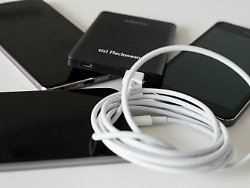If you want to get by with a smartphone without a removable battery for a long time without a socket, it is best to take a power bank with you to be able to charge the device on the go. Stiftung Warentest knows which devices are worth the money and which are not.
A quick portion of electricity to go for your smartphone: Many mobile phone users want this in their everyday life. Mobile additional batteries, also called power banks, meet this need.
Large power banks with nominal capacities from 10,000 milliampere hours (mAh) are more efficient than smaller power banks with lower capacities. Because they deliver more load in relation to their weight, reports Stiftung Warentest ("test", issue 6/2016).
Big is better, but smaller is also good
But even the smallest models with nominal capacities of 2200 to 3000 mAH do their job: They charge a smartphone about once, according to the product testers. This is enough for most users for their everyday life. If you need more juice on the go – for example on camping trips or for devices with more power requirements such as tablets – you can use larger batteries, which are usually a few centimeters wider than the smaller alternatives. With some of the additional batteries, two USB outputs allow several devices to be charged in parallel.
The product testers found negative differences between the usable amount of charge in the test and the manufacturer's information on some power banks. In the test, an additional battery delivered more than 1000 mAh less than the manufacturer had promised. Power bank buyers should also ensure that the nominal voltage of the batteries is usually around 3.6 volts. It has to be transformed to five volts when charging a mobile device via USB. This reduces the usable amount of charge.
Only one is very good
Stiftung Warentest tested a total of 20 additional batteries in four categories. The small power banks with a nominal capacity between 2200 and 3000 mAh ended up Real power (Ultron) PB-2600 (17 euros) and Samsung EB-PA300U (28 euros) at the top. Both achieved a grade of 2.5. The middle power banks with nominal capacities between 5200 and 6000 mAh cut Ednet Power Bank 5200 at best (grade 2.1 / 18 euros). Also "good" were Hama Power Pack Fusion 5600 (2.4 / 26 euros), PNY AD5200 (2.4 / 18 euros) and GP FN05M (2.5 / 20 euros) graded.
Won in the large additional batteries with nominal capacities of 10,000 to 13,000 mAh Intenso Slim Powerbank S10000, which was the only power bank to be "very good" (grade 1.5 / 20 euros). Almost as good – but three times as expensive – was Urban Revolt (Trust) Cinco Powerbank 13000 (Note 1.6, 60 euros). In general, it is noticeable that capacity is not necessarily a question of price. The price gap between the best devices in the three capacity categories is only three euros.
Solar energy is not enough
In addition, two power banks with solar cells were tested: They were only partially convincing. The devices can be charged via USB as well as from sun rays. Charging with the solar module takes time: after seven hours of sunshine, the power banks in the test were only charged to a fraction.
A mobile device can hardly be supplied with solar energy alone, according to the product testers. The bottom line was that they rated both solar power banks as "satisfactory".
. (tagsToTranslate) Technologie (t) Stiftung Warentest (t) Technik-Tests (t) Smartphone battery
